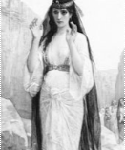 Jephthah’s Daughter
Jephthah’s Daughter
Victim of a Father’s Foolish Vow
1188 B.C.
For hundreds of years after the Israelites settled in Palestine they were governed by men called Judges (an elective office) who interpreted and enforced the Mosaic statues, and whose position was somewhat like the Greed “Ephors” or Roman “Consuls” and whose office seemed to have a life one, but was not hereditary.
In the intervals between these judges the people seem immediately to have adopted the customs and idolatry of their neighbors, and as a punishment fell under the rule of the nomad chiefs or petty kings surrounding them.
Jephthah was such a nomad chief who had been expelled from among the Israelites because of his birth. For eighteen years the Israelites had been subject to the oppressive rule of the Philistines and Ammonites, and they now entreated the aid of Jephthah, promising their rulership if he would lead their army in attempt to gain independence.
He consented, and made, after the custom of his time, a vow to sacrifice, as a burnt offering in case of victory, whatsoever should first meet him on his return to his own house. This proved to be his daughter, and it is recorded that, after the two months of delay, she asked for, “he did with her according to his vow.”
Human sacrifices were common. Was his daughter burned alive? Probably not, for these reasons:
- Jephthah was not an idolater, It was forbidden as an abomination by his Mosaic law;
- Only the priests could offer sacrifices and only the Levite could take the victim’s life, he was neither;
- Only a male victim could be offered;
- Burnt sacrifices could only be offered at Shiloh. There the high priest, Phineas, would not have allowed it;
- Redemption could have been secured by paying a small sum;
- His conduct is commended in Heb. IX:32, which would be atrocious if he had burned her.
The word he used was ne’-der, “consecration,” not cherun, “destruction.” The probabilities are that she was condemned to live a life of celibacy, which event the women of at that time celebrated yearly.
~*~
Reference: Woman: Her Position, Influence and Achievement Throughout the Civilized World. Designed and Arranged by William C. King. Published in 1900 by The King-Richardson Co. Copyright 1903 The King-Richardson Co.
